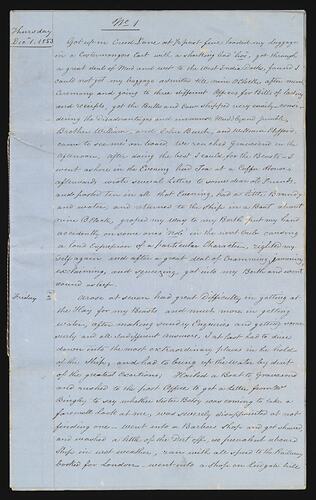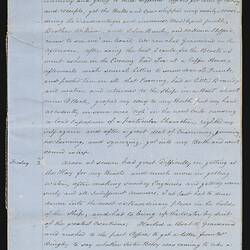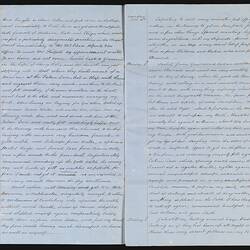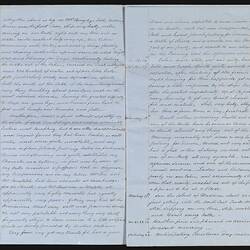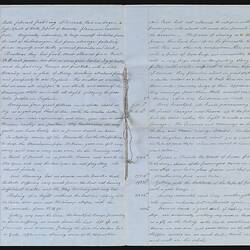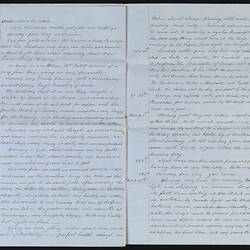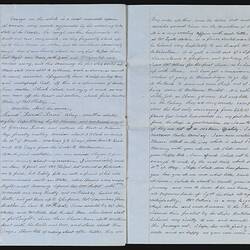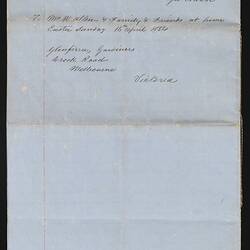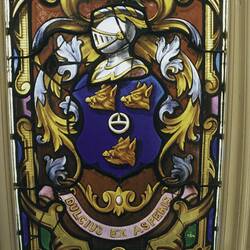Summary
Twelve page, handwritten letter by George Allen is a daily account of his voyage on the 'Essex' (which he describes as 'not a regular passenger ship') to Australia in 1853-54. He describes carting his luggage and his consignment of cattle to the West India Docks in London on 1 December 1853, sailing down the Thames and then waiting at Gravesend until the ship's departure, through to sighting Cape Otway on the Victorian coast on 10 March 1854 and casting anchor at Hobsons Bay two days later.
The last two pages describe his meeting with the man for whom he had transported the cattle, taking them to the Western District in Victoria and receiving his next commission to collect 2000 sheep and bring them down to Melbourne market. The letter was transcribed by George Allen one month after he arrived in Melbourne, probably from notes he made during the journey as it is chronological and written in the form of a travel log.
George is obviously an educated and highly literate man. His letter is written with much colour, wit and warmth. He describes the challenges in maintaining livestock on board, the leaky ship, the unsatisfactory food and his own success at cooking, crossing the equator festivities, as well as experiences on a western district cattle station.
Physical Description
12 page, double-folded letter on blue foolscap ledger paper, tied at centre spine with string at three points. Script written in black ink. Dates entered in left hand margin, commencing with 'Thursday Dec 1st 1852 and ending with '10th (March 1854)'. Front page headed 'No 1'. Final page signed 'Geo Allen' to 'Mr W Allen & Family & Friends at home Easter Sunday 16th April 1854' from 'Glenferrie, Gardiners Creek Road Melbourne Victoria'.
Significance
This letter is a significant addition to the museum's collection of 19th century migrant letters and diaries. These personal accounts of the voyage and early life in Victoria offer valuable insights into 19th century shipboard experiences, and what newly arrived immigrants did - how they left the ship, where they stayed, where they settled, how they were employed, and the nature of their working, social and cultural lives.
This letter was transcribed by George Allen one month after he arrived in Melbourne, probably from notes he made during the journey as it is chronological and written in the form of a travel log. It is also in excellent condition and very evenly written on ledger paper. However a close reading reveals two points where a sentence hangs unfinished and a phrase is repeated, which might even suggest that this document is actually a subsequent transcription of George's original letter, although probably still 19th century.
George sent the letter to relatives back in England, which explains how it came to be amongst the papers of his English descendants. The letter is headed 'No. 1' - perhaps it was (or was to be) the first of a series of diary style letters to be sent back to England. Or perhaps this indicates that this copy is number 1 of multiple copies.
George's letter is a daily account of his voyage on the 'Essex' (which he describes as 'not a regular passenger ship') to Australia - from carting his luggage and his consignment of cattle to the West India Docks in London on 1 December 1853, sailing down the Thames and then waiting around at Gravesend until the ship's departure (Gravesend is a town in northwest Kent, England, on the south bank of the Thames, opposite Tilbury in Essex); through to sighting Cape Otway on 10th March 1854 and casting anchor at Hobsons Bay on the 12th March.
The last two pages describe his meeting with the man for whom he had transported the cattle, taking them to the Western district and receiving his next commission to collect 2000 sheep and bring them down to Melbourne market.
George is obviously an educated and highly literate man. His letter is written with much colour, wit and warmth. He describes the challenges in maintaining livestock on board, the leaky ship, the unsatisfactory food and his own success at cooking, crossing the equator festivities, as well as experiences on a western district cattle station.
George sends his letter from: 'Glenferrie, Gardiners Creek Road, Melbourne.' 'Glen Ferrie' was the property of Peter Ferrie, who bought allotment 21 at the land sales in June 1840; allotment 21 ran from Gardiner's Creek Road (now Toorak Road) north to Gardiner's Creek, and to the east of what is now Glenferrie Road. Ferrie is thought to have constructed a house by 1841. The property was subsequently purchased by James Fergusson, who constructed a new house on the land in 1872; the Museum Victoria collection includes the stained glass window from this house [HT 521].
More Information
-
Collecting Areas
-
Acquisition Information
Donation from Robert (Bob) A. Cliff, 15 Aug 2007
-
Author
-
Inscriptions
Text: Thursday/Dec 1 1853/No 1/Got up in Creed Lane at 1'2 past five loaded my luggage/in a Costermongers Cart with a shocking bad "hos", got through/a great deal of mud and went to the West India Docks, found I/could not get my baggage admitted till nine o'clock, after much/ceremony and going to three different Offices for Bills of lading/and receipts, got the Bulls and cow clipper very easily-consi-/ering the Disadvantages and immense muddle, and jumble.
-
Classification
-
Category
-
Discipline
-
Type of item
-
Overall Dimensions
202 mm (Width), 2 mm (Depth), 327 mm (Height)
-
Keywords
English Immigration, Letters, British Immigration, Shipboard Travel, Cattle, Sheep, Sheep
